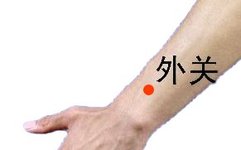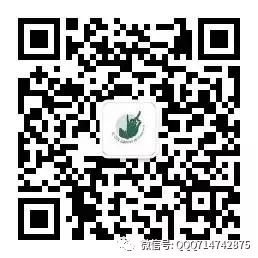Author: Wuzhu Jushi
External pathogenic diseases are a term from Traditional Chinese Medicine (TCM). So, what are external pathogenic diseases? In simple terms, they refer to various diseases caused by external factors such as wind, cold, heat, dampness, dryness, and fire. Common colds are a typical example of external pathogenic diseases!
No matter which external pathogen causes the external pathogenic disease, we can achieve varying degrees of efficacy by finding a specific acupuncture point! This point is the Wai Guan (Outer Pass) point, which is one of the meeting points of the eight extraordinary meridians, connecting with the Yang Wei Mai (Yang Linking Vessel). Since the Yang Wei Mai regulates all Yang energies, and all three Yangs belong to the exterior, the Wai Guan point can be used to treat all external pathogenic diseases.
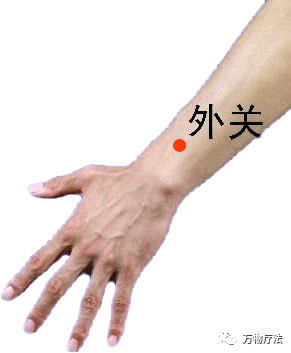
Regarding the ability of the Wai Guan point to treat all external pathogenic diseases, it is also recorded in the Ming Dynasty medical text by Li Ting, titled Yixue Rumen: Zhabing Xuefa Ge: “All wind, cold, heat, and dampness evils, headaches, and fevers can be treated at the Wai Guan point.”
Preventing disease is better than treating it. If we utilize the Wai Guan point effectively, it has a strong function in disease resistance and prevention. In the system of Da Xun Zhi Jiao Yin Shu (Great Circulation Finger Moxibustion Technique), there is a method called Jin Zhong Zhao (Golden Bell Shield) Guiding Method, which involves using the Wai Guan point to activate its internal energy, helping our body build an invisible golden bell shield that prevents external evils such as “wind, cold, dampness, and fire” from invading!
The Wai Guan point is also very susceptible to stagnation because it is a crucial checkpoint for Qi and blood in our body. The Qi and blood between the interior and exterior of the meridians often exchange here. Since this point is deeply hidden between the ulna and radius, Qi and blood can easily accumulate and fail to disperse, leading to various hidden dangers affecting the function of internal organs.
Therefore, to maintain a healthy body, we must prevent stagnation! We should regularly massage this point to avoid blockage!
Additionally, if we encounter the following issues in clinical treatment or daily life, we can also seek help from the Wai Guan point.
For example, in clinical practice, conditions such as sciatica, low back pain, rib pain, shoulder pain, headaches, difficulty in finger flexion and extension, upper limb paralysis, hand tremors, spontaneous pneumothorax, kidney stones, ankle sprains, and mastitis can all benefit from the Wai Guan point.
In daily life, if we experience heat stroke, motion sickness, seasickness, or vomiting, strong pressure on the Wai Guan point can alleviate these discomforts.
For the elderly, regular massage can prevent symptoms such as hearing loss, tinnitus, and deafness.
Those who often suffer from dry eyes or tearing in the wind should not forget this acupuncture point, as it has excellent effects on correcting eye function disorders.
Thus, whether used in clinical treatment or for daily health maintenance, the Wai Guan point is particularly practical.
We can incorporate the Wai Guan point into our daily lives, as it brings only benefits and no drawbacks. For instance, while watching TV, we can massage it to enhance immunity and prevent various colds.
Where is the Wai Guan point located?
It is easy to find; it is located on the outer side of the forearm, 2 inches above the wrist crease on the dorsal side, at the midpoint between the ulna and radius, as shown in the image below.

When locating the Wai Guan point, do not rigidly memorize it as a single point; instead, consider it as an area. Therefore, when searching for the Wai Guan point, the key is to find the most painful and sore area within the Wai Guan region.
Since the Wai Guan point is deeply hidden between the ulna and radius, it requires strong pressure to exert its effects. When massaging, push down along the direction of the point.Those with a stick needle can use it instead of fingers for better results!
For those familiar with Daoist rope therapy, using rope therapy techniques will be even more convenient!
Here is a simple version of the rope therapy technique for reference: use a tourniquet to bind the Wai Guan point, then add a small stick inside to complete it, as shown in the image below:
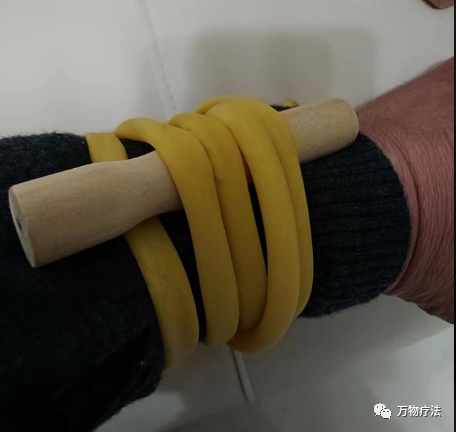
The small stick in the image is a bit large; it is better to find a smaller stick to place in the gap between the ulna and radius, then bind it. Its effect is comparable to acupuncture. After binding, the wrist can be rotated occasionally to increase stimulation intensity. For more information on rope therapy, please refer to the article published on December 11, 2022, by the Wànwù Liáofǎ (All Things Therapy) public account titled “Lazy Person’s Treatment Method – Daoist Rope Therapy”.
Disclaimer: Recently, several public accounts have plagiarized our original articles, such as “Anyone with tinnitus will have hard objects here” and “After the beginning of spring, activate the ‘Hui Chun Xue’ to synchronize our bodies with spring!” From today onwards, any public account that plagiarizes our original articles will face legal consequences!
Recommended Previous Articles:
1. One Acupuncture Point for “Deep Regulation” of the Body
2. Using Fingers as “Moxibustion” is Inexpressibly Wonderful
Stay tuned for more exciting content tomorrow…
The first is “Wànwù Liáofǎ” |
This public account allows you to quickly master various “simple, practical, easy to learn, and effective” TCM health preservation techniques, helping you understand that everything in the universe can be a good medicine if used correctly.
|
The second is “Qián Yì Sì Diǎn Xu锓 This public account mainly helps you decipher the various magical mysteries of the “subconscious”. Anyone who understands the wonders of the “subconscious” can make their life smooth sailing… |
|
The third is “Tóubǎn Jiànkāng” |
While a specialist can only see one patient at a time, a good medical or health article can benefit thousands. That is what “Tóubǎn Jiànkāng” aims to achieve.
|
There are two methods: 1. Long press the QR code image below, then click “Recognize the QR code in the image”, and finally click “Follow” to add.
(“Wànwù Liáofǎ” QR code image)
“Qián Yì Sì Diǎn Xué” QR code image
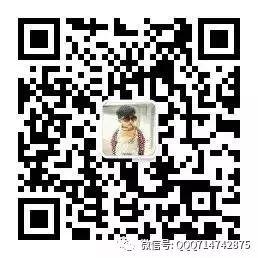
“Tóubǎn Jiànkāng” QR code image
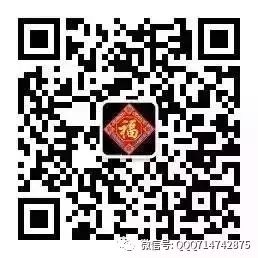 2. Open the QR code scanner on WeChat, align it with the image above, and scan to follow.
2. Open the QR code scanner on WeChat, align it with the image above, and scan to follow.

